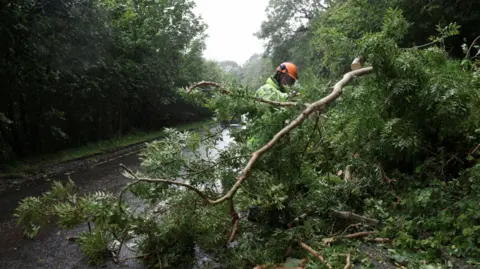Storm Floris has caused widespread disruption across Scotland, resulting in significant power outages and travel disturbances. As of Tuesday, August 5, efforts to clear the aftermath of the storm, which had previously issued an amber weather alert, were ongoing. The Scottish and Southern Electricity Networks (SSEN) reported that nearly 50,000 households were still without power, highlighting the storm’s serious impact on the region’s infrastructure.
According to SSEN, restoration teams were diligently working to reconnect homes; by the previous evening, approximately 9,000 households had regained their electricity, while efforts continued for around 43,500 more. The company described Storm Floris as “the most damaging summer storm in recent memory,” with particular devastation observed in areas such as the Highlands, Moray, and Aberdeenshire. In response to the situation, free hot meals and drinks were being provided at various locations for those affected while waiting for their power supply to be restored.
Winds reaching speeds of 90 mph were recorded in several areas, leading Network Rail to report 119 incidents across Scotland on Monday alone. The railway operator announced that its teams had been working “tirelessly” to clear train routes obstructed by fallen trees and other debris. The storm was expected to bring additional winds of up to 70 mph in Orkney and Shetland, prompting the Met Office to maintain a yellow weather warning until 08:00 the following day.
The Scottish government convened an emergency meeting on Monday night to address the storm’s “significant disruption.” Home Affairs Secretary Angela Constance urged people to minimize travel until conditions improved, citing the ongoing power outages that affected many properties. The situation was compounded by travel advisories; flights and ferry services were suspended, and major road bridges were closed to high-sided vehicles due to dangerous conditions. Some vehicles were reportedly overturned in areas like Glasgow and Skye.
As the storm subsided, recovery continued, with various travel advisories still in effect. Transport providers like ScotRail were encouraging passengers to check journey updates via their app, website, or JourneyCheck before heading out, as disruptions on the rail network were expected to persist throughout Tuesday. The SSEN has committed to provide timely updates as the day progresses to keep affected customers informed.
The Scottish government emphasized their commitment to public safety as they continued to assess the situation. Constance noted that while recovery efforts were well underway, the weather had the potential to delay scheduled services, including the delivery of exam results for students in Scotland’s islands. Additionally, events like the Royal Edinburgh Military Tattoo were canceled due to the weather.
A Met Office amber warning, covering an extensive area from the central belt to the Highlands, expired at 23:00 on Monday. Observations indicated that the highest winds were recorded in western coastal regions, with gust patterns shifting northeast as the storm advanced. The Met Office indicated that the strong winds were particularly problematic because trees were in full leaf, increasing the chances of being blown over or having branches snapped.
Looking ahead, Tuesday was anticipated to be a calmer day as Storm Floris moved further away towards Scandinavia, allowing for a more coordinated response to the damage caused by the storm. In summary, while the immediate danger posed by Storm Floris appears to be receding, the impact on infrastructure and public services will take time and resources to fully address.












